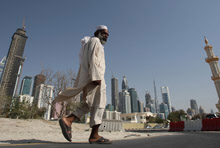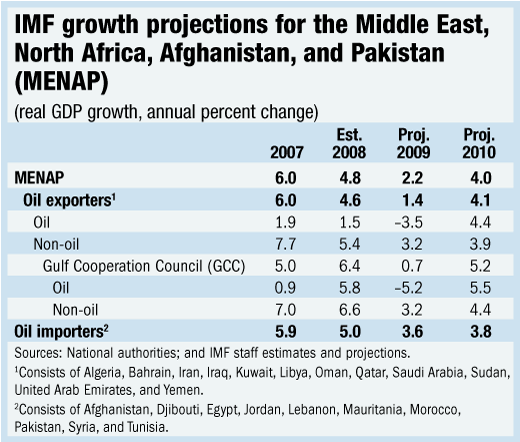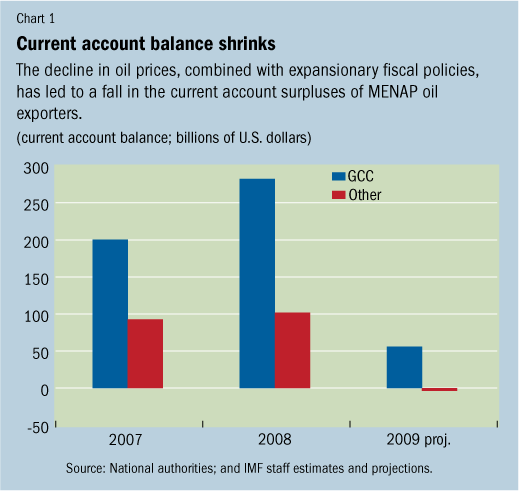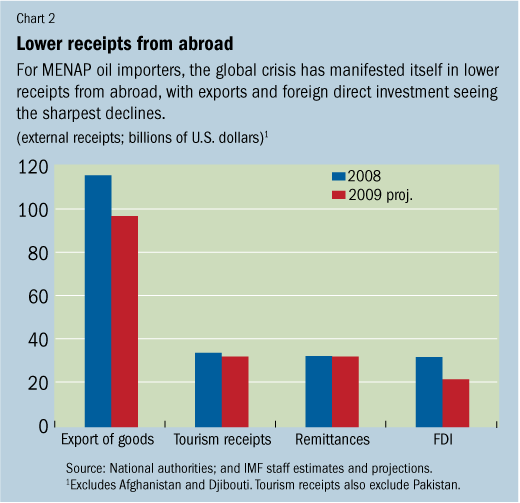
Typical street scene in Santa Ana, El Salvador. (Photo: iStock)
IMF Survey: Sound Policies Soften Crisis Impact on Middle East
October 11, 2009
- Oil exporters draw on large reserves to lessen effects of crisis
- Oil importers only moderately affected; recovery also likely to be muted
- Countries should support domestic demand, but keep debt at sustainable levels
Oil exporters in the Middle East and North Africa have been directly hit by the global financial crisis through a sharp drop in oil prices and a drying up of capital inflows, but the blow has been softened by countercyclical government spending, according to the IMF’s new regional forecast.

A worker in Dubai: In some GCC countries, large public investment projects have helped stem the downturn (photo: Karim Sahib/AFP)
REGIONAL ECONOMIC OUTLOOK
IMF Middle East and Central Asia Department Director Masood Ahmed told an October 11 press conference in Dubai that lower oil production resulted in a 3.5 percent drop in oil GDP, but non-oil GDP continued to grow, although moderating to 3.2 percent. In 2010, both oil and non-oil GDP growth are projected to pick up to around 4 percent.
For the region’s oil importers, the slowdown has been less severe, thanks to its low degree of integration with global capital markets, limited exposure of the banking system to structured financial products, and its small manufacturing base. But if the downturn for these countries has been mild, the rebound will be similarly modest, Ahmed said at the briefing, which focused on the outlook for the Middle East, North Africa, Afghanistan, and Pakistan (MENAP).

Oil exporters withstand the shock
The Regional Economic Outlook: Middle East and Central Asia divides MENAP countries into two categories: oil exporters and oil importers.
The oil exporters comprise the six countries of the Gulf Cooperation Council (GCC)—Bahrain, Kuwait, Oman, Qatar, Saudi Arabia, and the United Arab Emirates—and Algeria, Iran, Iraq, Libya, Sudan, and Yemen. Together, these countries account for 65 percent of global oil reserves and 45 percent of natural gas reserves.
With the large drop in oil prices—from a peak of more than $120 per barrel in the summer of 2008 to around $30 per barrel at the beginning of 2009—and subsequent cuts in oil production, oil exporters (particularly the GCC) were hard hit.
Drawing on substantial reserves built up prior to the crisis, governments responded with expansionary fiscal policies and liquidity support to their financial sectors, which has helped contain the impact on the broader economy. These policies are also helping maintain relatively high levels of imports during the crisis, which, in turn, contributed to mitigating the global downturn. As a consequence, the current account surplus of these countries dropped by nearly $350 billion (Chart 1).

With higher oil prices and the anticipated reemergence of global demand, oil revenues will increase, allowing oil exporters to rebuild their international reserve positions—by more than $100 billion in 2010. This, in turn, provides the basis for maintaining public spending. With the GCC’s share of world imports expected to increase from 2.7 percent in 2008 to 3.2 percent in 2009 and 2010, the region’s contribution to global demand will remain solid.
While most banks in the region were not exposed to toxic assets, they have been hit by the collapse in domestic asset markets and the withdrawal of foreign funds. However, prompt and forceful policy action has contained the fallout.
Oil importers to see slow recovery
For the MENAP oil importers—Afghanistan, Djibouti, Egypt, Jordan, Lebanon, Mauritania, Morocco, Pakistan, Syria, and Tunisia—the slowdown has been less severe than in many other emerging markets, given their limited integration with global capital markets and positive spillovers from the region’s oil exporters. While more limited in scope, countries have also responded with appropriate countercyclical policies.
The global slowdown’s main transmission channel has been a reduction in receipts from abroad (Chart 2). Merchandise exports and foreign direct investment have been hardest hit, and are projected to decline by 16 percent and 32 percent, respectively, in 2009. Tourism receipts and remittances are also lower, but not by as much.

Oil importers in the Maghreb (Mauritania, Morocco, and Tunisia) have been highly exposed to the slowdown in the European Union, their main partner for trade and remittances. In Morocco, however, an exceptional agricultural harvest has mitigated the impact of the global economic slowdown on overall output.
Growth for the oil importers is projected to fall from 5.0 percent in 2008 to 3.6 percent in 2009. Looking ahead, growth is projected to remain fairly flat in 2010, mainly because of a slow recovery in advanced economy trading partners and limited scope for further countercyclical policies.
Policy challenges
For oil exporters, the crisis has revealed some shortcomings in the region’s financial sector, notably weak risk management systems and overleveraged institutions. Looking forward, continued strengthening of financial regulation and supervision—already being instituted in some countries—will be crucial.
Continued public spending on infrastructure and social development will be key to helping realize these economies’ potential. Governments will also need to begin designing strategies to unwind the exceptional liquidity support provided to mitigate the crisis impact.
Financial market development—including diversification beyond a bank-based system—will remain a medium-term priority, as will efforts to improve the business climate to support economic diversification and generate employment.
For oil importers, high debt levels limit the space for fiscal stimulus in most cases, and the scope for monetary easing will be constrained by an anticipated increase in global interest rates from current historical lows. Policymakers, therefore, need to focus more on supply-side reforms to boost private sector activity and employment, and strengthen competitiveness. In countries without fixed exchange rate regimes, greater exchange rate flexibility will facilitate these goals.
Comments on this article should be sent to imfsurvey@imf.org







